![[Joe Clark: Accessibility ¶ Design ¶ Writing] Joe Clark: Accessibility ¶ Design ¶ Writing](/joeclark-angie-02IX.jpg)
![[Joe Clark: Accessibility ¶ Design ¶ Writing] Joe Clark: Accessibility ¶ Design ¶ Writing](/joeclark-angie-02IX.jpg)
This response pertains to the FCC’s 2010 Public Notice (CG 05-231; ET 99-254) on closed-captioning rules. My focus is on captioning standards.
This submission is permanently located at joeclark.org/fcc2010/. (FCC’s filing-system version. My reply comments.)
It isn’t fair to say the free market, left to its own devices, would provide no captioning whatsoever. History proves otherwise. But it also proves that the free market will provide so little captioning it amounts to illegal discrimination against deaf people. We imposed captioning quotas, by law and regulation, to redress such discrimination.
But history and our experience up to this very second prove the free market will provide captioning that sucks. We can talk about the problem or we can solve the problem. I’m proposing a solution.
I am a journalist and author whose interest in accessibility for people with disabilities dates back nearly 30 years. I wrote the book Building Accessible Websites (New Riders, 2001). The Atlantic Monthly dubbed me “the king of closed captions,” albeit so long ago it is old news. I worked within accessibility-related standards bodies like the W3C and PDF/UA until it became obvious that was a fool’s errand. I have given various public presentations on captioning issues, including captioning typography.
Unlike other respondents, I have 30 years’ near-continuous experience watching captioning – in four countries, no less. This will become an important point later.
The FCC’s minimum quantities of captioning make for nice soundbites and more or less ensure that captioning isn’t completely absent from most of the shows people watch. But requiring a certain amount of captioning without regard to how it’s done reeks of a regulation that doesn’t understand the thing it is regulating.
It seems that most people with the power to make decisions either do not care to learn much about captioning or resent captioning outright. To them, captioning is a deceptively straightforward task: Write down what people say. If they glance at a monitor and see words that vaguely correlate to the audio, they consider the job done. We can view this attitude an example of the Anything’s Better Than Nothing fallacy of captioning.
Anything is better than nothing, but we’re talking about two important issues here: The legal rights of viewers with disabilities and the artistic integrity of the original program. The latter point is not to be taken lightly; even the worst TV show, the show whose very existence bothers you, the show you wouldn’t watch if your life depended on it, the show that’s well beneath your dignity, has artistic merit. There may be lousy TV shows, but there should never be such a thing as lousy TV captioning. If you can’t agree with that notion, I don’t know why you’re part of this discussion.
Because FCC regulations explicitly permitted broadcasters and VDUs to stuff anything at all into the vertical blanking interval and call it “captioning,” broadcasters, producers, and distributors have gone right ahead and done exactly that. The Anything’s Better Than Nothing fallacy is taken to the absurd extreme of insisting viewers must accept whatever el-cheapo “captioning” that somebody higher up the food chain is willing to pay for.
There really is no analogy with other industries. This is not like requiring seatbelts but not brakes in automobiles. It isn’t like requiring wheelchair ramps but allowing ramps at a 45° angle. Captioning is sui generis because it involves fleeting displays of the written word that must be instantly understood even while picture and sound are simultaneously presented. Captioning is not straightforward and is easy to get wrong.
No matter how bad you think captioning is, somebody can always make it worse.
Captioning lifers will recall the early open captioning on PBS programs like The Captioned ABC News. The first time we saw the future – Line 21 closed captioning – we lost our marbles. Overnight we went from self-evidently correct captioning – full-screen positioning, mixed case, proportional spacing, colour when needed – to horrific dot-matrix capitals in white on a black background, quasi-centred at best but mostly in flush-left blocks. Could it get worse? Sure, as it turns out. Worse is all it’s gotten.
Just since the FCC captioning regs took effect:
NBC Universal – of the incumbent networks, by far the most contemptuous of captioning – auctioned its captioning contract to the lowest bidder. Which poor saps won that auction? The captioner that bills itself as having the largest offline-captioning staff in the U.S., CaptionMax. Let’s learn more about them.
CaptionMax evolved from an interchangeable commodity captioning vendor working in all caps to a commodity vendor using mixed case and back again. Then it devolved into a subpar vendor writing captions as bottom-centred “subtitles” of no more than two lines in length. (And, a source informs me, with a lot of transcription done in India – a place where, as any caller to a tech-support line knows, they don’t speak American English.)
All-all-caps, all-bottom-centred captioning is barely comprehensible on a good day and, frankly, ought to be banned.
Now, who knows why the company that bills itself as “Faster. Better. Nicer™” took these steps? Theories:
CaptionMax “won” the NBC reverse auction. Price lowballing forced founder Max Duckler to cut corners somewhere, so caption positioning was thrown out the window. (What we have now is a parody of caption positioning. All-bottom-centre “captions” are scrollup captions photographed as still pictures.)
NBC is a partner in Hulu, and Hulu assigned a lot of its Chinese developers the task of figuring out captioning. As foreigners, all they understand is subtitling; CaptionMax “captioning” works immediately in an online system that can’t differentiate subtitles from captioning. (In other words, if all the kool kidz watch TV on Hulu and all they’re going to get is bottom-centred captions there anyway, why not set them up like that beforehand?)
Nonetheless, CaptionMax’s unwatchable captions, now seen everywhere from The Office to Sesame Street (!), are emblematic of the decline of captioning: It always get worse.
Broadcasters and producers who don’t understand or simply hate captioning think real-time captioning works for nonfiction prerecorded programs. It doesn’t, not least of all because the program is not live and such captioning is guaranteed to contain errors. (Then those errors are never fixed, at all, ever; the tape with the real-time captioning is endlessly replayed far into the future.)
Or they think that real-time or, much more commonly, scrollup captioning works for fictional narrative programming. Again, it does not. It is impossible to follow a drama or comedy, to take two examples, using scrollup. It can’t be done. You might as well just print us out a transcript and snailmail it. Scrollup captioning is a disembodied entity wiggling somewhere distant from the fictional program; pop-on captioning is actually part of the show.
Turner Classic Movies is especially prone to butchering “classic” movies with scrollup captioning. Essentially all Spanish-language captioning is scrollup, even fictional shows, as is every soap opera I know of, some of which used to be captioned in pop-on.
Difficult material devolves from the rare high-quality shop to whoever’s cheaper. JR Media Services did a creditable job captioning a quintessential writer’s show, Mad Men, with its demanding period argot. Captioning was then devolved to uncredited hacks who literally cannot understand the show they’re trying to caption. I assure you I am not the only person who noticed.
I blame the broadcaster, AMC, for this, because the same thing happened with its other shows, like Breaking Bad and The Walking Dead.
AMC is also guilty of a new low it can call its own: Forcing captioners to pre-censor dialogue. Even pejoratives as benign as shit, goddamn, and balls are replaced, wholly or partially, with asterisks. But AMC’s hack-job captioner is so clueless about its own medium it does not understand that * requires special handling in captioning (it’s in the extended character set at [12,28]).
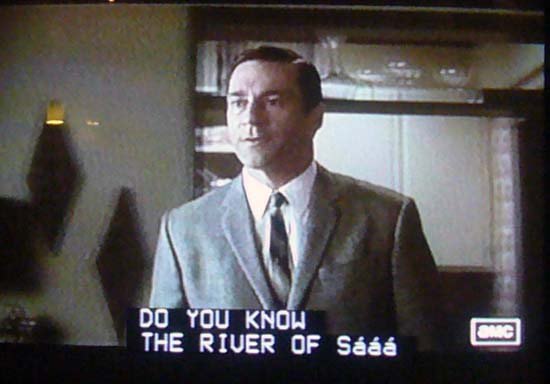
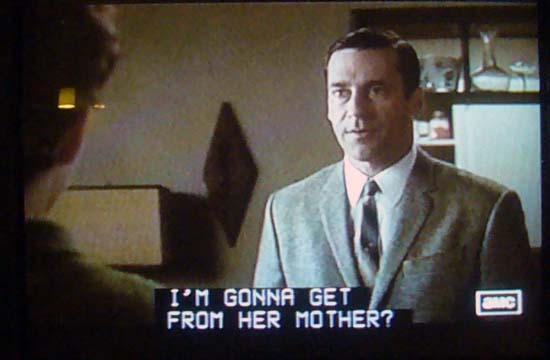
Again, I’m not the only one who noticed.
Now, why did they do it? To cheap out, of course. Eventually there will be a syndication edit with cleaned-up audio, and somebody at AMC decided that even the puny 30% extra it would cost to recaption at that point was too much money to spend. Meanwhile, how much do those coveted advertising spots on Mad Men go for?
The lesson here is that NBC isn’t the only broadcaster that schemes and plots all year to wring its captioning budget dry. It’s just easier to shaft the deaf. Nobody got into this business to help cripples, did they?
Captioners gutted their operations: WGBH closed what it was always proud to tell us was “the world’s first captioning agency,” located at its Western Ave. headquarters in Boston. (A few stragglers remained. But essentially all captioning, even local Massachusetts programming, was sent to the L.A. office.)
A perennial misuser of government grant money, NCI, locked out its unionized staff and has never quite clarified whether or not it sends work overseas, or whether, when that happens, clients know about it.
The United States is being invaded by foreigners: Bizarre, failed U.K. “subtitling” is being transcoded to Line 21 with essentially no changes. (The only alteration I can detect is seen in failed U.K. music “subtitling,” where # changes to Line 21–standard ♪. At an underlying level, though, it’s the same character.)
Compare these identical scenes from Sherlock (2010) captioned by Brits and by Americans. Start with this centred mass of unreadable characters, which makes all dialogue seem to be coming from Dr. Watson. (Only Sherlock Holmes actually speaks.)
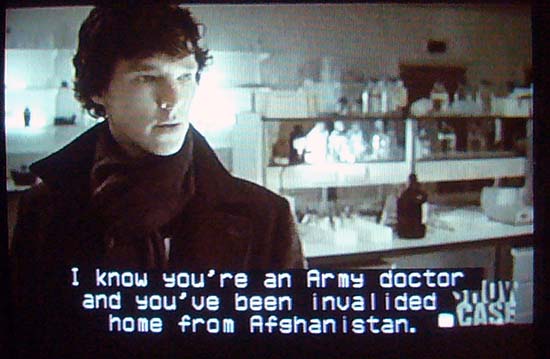
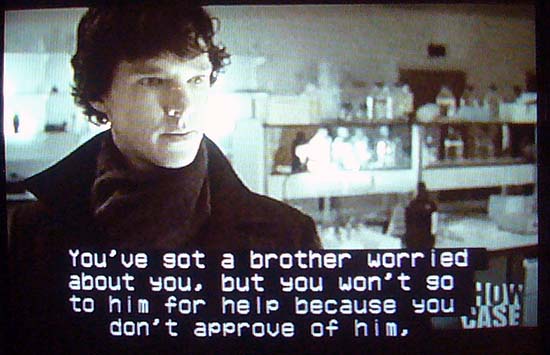
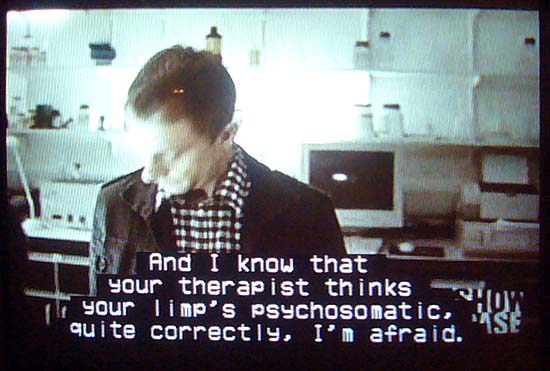
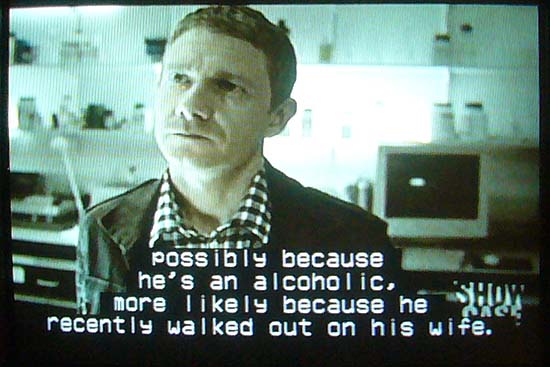
Compare that with the same scene in legitimate captioning, with verbatim transcription, readable caption chunking, and actual positioning.
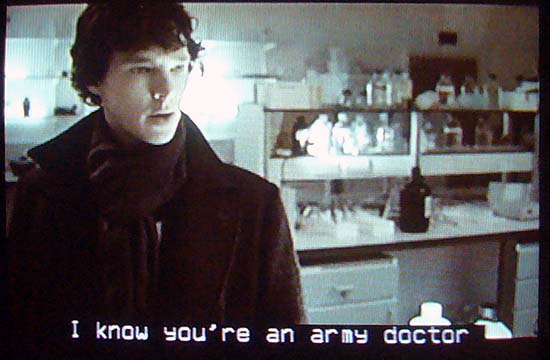
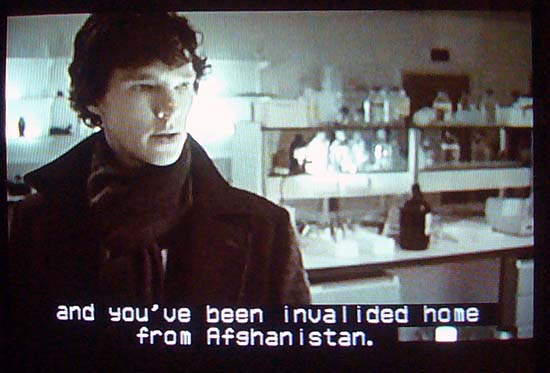
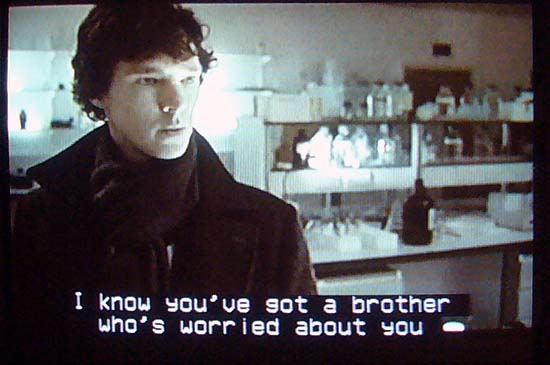
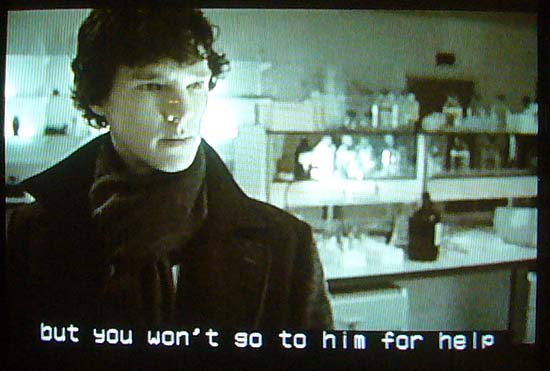
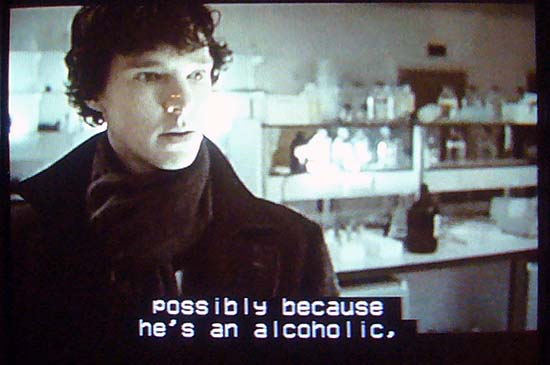
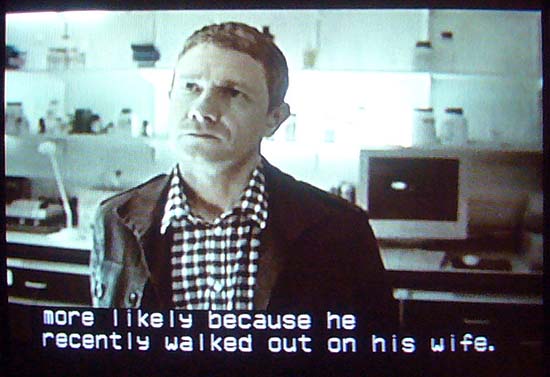
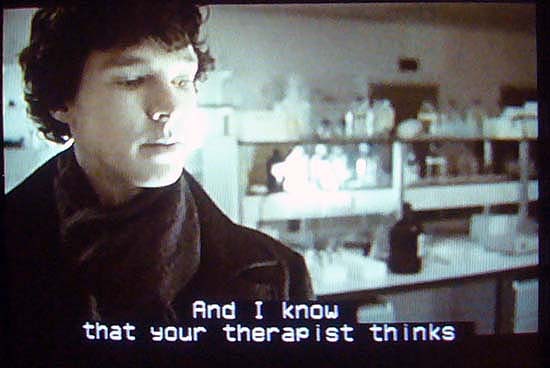
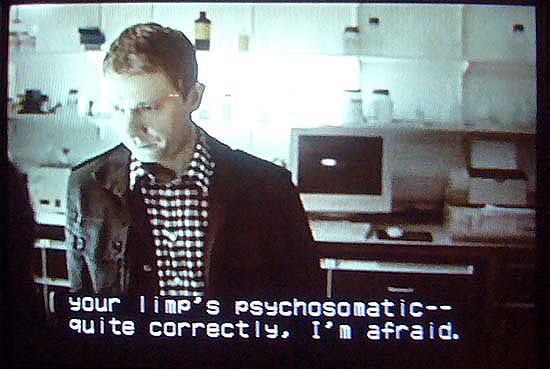
So: That’s what’s happening in captioning today. Had anyone else noticed? Did you notice? Is this the first time you’ve heard of these facts? (Do you even watch captioning? )
A complaints-driven system is a proven failure, the FCC’s improved procedures notwithstanding. It borders on impossible for a viewer to file a complaint about captioning. (Really, how do you do it when you’re lying on the couch watching TV at night?)
It is time to distance ourselves from a reactive and adversarial complaint process that has proven not to work. And the only way to do that is to establish and impose up front a set of standards that are independently developed, tested, researched, and proven to improve quality.
Legitimate standards are urgently needed now. Such standards have to be developed outside the incumbent captioning industry. They have to be tested to prove they work. Then a certification program must be developed for practitioners. Then standards have to be imposed across the board. Only at that point can we claim we have achieved accessibility.
Now, why do the standards have to be independent?
Every captioning house does things differently. This is a bug, not a feature. It is the problem in a nutshell. Yet in an enduring conceit of the industry, every captioner believes Our Captions Are Better Than Theirs. But every captioner’s work cannot possibly be better than everyone else’s. Different is all it usually is.
If asked, captioning lifers could venture their own priority lists of captioners to use for prerecorded shows.
We never suggest using a postproduction house; the place that duplicates your tapes doesn’t know how to caption. (Don’t waste your time hunting for exceptions.)
We caution against mom-’n’-pops, since they’re too understaffed and work only on the most marginal shows, including porn.
Banal mainstream caption factories like Vitac give you banal mainstream work. (Now we have a new subcategory of banal mainstream shops that undercut their own legacy, and it’s a growing list – CaptionMax, NCI, WGBH.)
At the top end are high-quality captioners that can barely eke out a living, like Captions, Inc. and JR Media Services.
The fact that such a list can actually be compiled should be a warning sign. Within a single presentation method (e.g., pop-on captioning), there shouldn’t be such a thing as different kinds of captioning. There should just be captioning. It should be impossible to identify the caption house just from what is dismissively called captioning “style.” Discrepancies in captioning style are something to be eliminated.
Captioning is not a venue for innovation or one an invitation to demonstrate your individuality and creativity. It is not a place for one captioner to manifest differences, most of them marginal, from other captioners’ work. By now, there is no new way to caption. All we have are different ways to caption, which differences are a restatement of the problem.
Eliminate the issue of style and then the discussion turns to quality of execution, and for that to happen we’ll need independently developed, tested, and proven standards imposed by law or regulation.
Broadcasters constantly lowball captioning companies on price. Hence captioners have had to hire people willing to work cheap. That means subcontracting to foreign countries that don’t speak U.S. English or hiring an undifferentiable mass of inexperienced young adults.
Any captioning lifer will confirm – as from the experience of the now-destroyed Caption Center at WGBH Boston, or from that of Captions, Inc. – that an older but varied workforce can do a good job of captioning.
A typical such workforce has in its midst a lot of gay males; Jews; experienced writers, editors, and proofreaders; and other unrepentant sticklers.
These groups lead lives in which they have read, written, spoken and listened widely. The vastness of their linguistic diet leaves them unfazed by terminology. They have extensive general knowledge and are rarely flummoxed by the topics of the programs they caption.
They know where to look to find the answers to terminological questions. Plus they can just ask each other for help; this is a group in which somebody probably will know the answer to a question.
Quite in defiance of the lessons of The Mythical Man-Month, here adding more captioners actually makes captioning better and faster.
But those aren’t the captioners getting hired these days.
The typical offline captioner nowadays is a female in her early 20s who recently graduated with a liberal-arts degree with barely any value in the job market – chiefly English literature, which offers no tools or training to caption real-world TV shows. (Your master’s thesis on Chaucer does nothing to equip you to caption Two and a Half Men.)
The monoculture of young college graduates ensures that everyone has more or less the same lacunæ in their knowledge, so that if one captioner ever manages to actually double-check the work of another, both can be relied upon to get the same things wrong. They see right through each other’s mistakes.
These captioners are too young and green to have developed adequate knowledge and vocabulary to do captioning well. Yet these are the people captioning your shows – because middle-aged sticklers cannot and will not work for peanuts.
The experience from Canada and the U.K. irrefutably shows that the captioning industry, left to its own devices, will write down what it already does and call it a “standard.” Such a standard rarely bans any specific practice and leaves so much wiggle room that centred all-caps captions can be deemed to comply as handily as positioned mixed-case captions.
Captioners are provably not interested in standardizing their methods if it means changing those methods. Captioners want standardization as long as the standard corresponds exactly to what they’re already doing. Captioners will never vote their own stylistic discrepancies out of existence. Standards, therefore, have to be legally imposed from the outside to overcome captioners’ self-interest.
Industry organizations, like the CEA, are even less willing to recommend significant change, no matter how necessary. The standard for HDTV captioning (CEA‑708) is a cautionary tale of poor design; vague, sometimes incomprehensible, often misspelled writing; and a complete botching of fields outside the expertise of a committee dominated by engineers (e.g., typography, the actual instrument of captioning).
The FCC or any other U.S. government department is not in a rational position to form a committee to develop a captioning standard. A few deaf and hard-of-hearing organizations would be invited along for the ride, but the committee would be dominated by incumbent captioners. WGBH Educational Foundation, recipient of endless grant money for accessibility “research” and a perennial member of every committee under the sun, would take its place on such a committee as if by birthright and would pretty much run the thing.
A further point on grant money: It taints the process. A standardization committee formed by a U.S. government agency whose members are recipients of U.S. government funds constitutes a clear conflict of interest. Those parties are all beholden to the same paymaster.
The solution to the problem of poor-quality U.S. captioning is to let an independent research group in a neighbouring country write the standard. I refer to my proposed nonprofit research and standardization body, the Open & Closed Project, which will develop global standards for captioning (among other things ) based on research and evidence. Where there isn’t any research or evidence on a certain topic, we’ll actually do it. And unlike other standards bodies, which have hefty membership fees or are dominated by incumbents, everyone may contribute to the development of the Open & Closed Project’s recommended practices.
To prove the standards actually work, we’ll spend a year beta-testing them in the real world. The resulting published standards will, moreover, be licensable for free, though books and physical media carry a cost. Afterward, training programs will be established; it will then finally be possible to pursue offline captioning as a legitimate field of study. Graduates can be certified as proficient in Open & Closed Project practices. Producers, broadcasters, and, yes, regulators can all require their contractors to be Open & Closed–certified.
At the end of the process, we won’t have to contend with n varieties of captioning from n different providers. Advocates have argued for decades that accessibility should be an integral part of the production process instead of tacking it on at the very end. With standardized practices, we’ll come as close as we ever have to reaching that goal.
The Open & Closed Project is an unfunded project. It might cost $5 million at the outside. It has a great deal of grassroots support (even CaptionMax supported it!), but because it is the only proposal that will actually solve the problem, it is held in something akin to contempt by Canadian broadcasters and the Canadian broadcast regulator, the CRTC. We must be on to something if they hate us that much. This would be a bad time for Americans to replicate that contempt. I’m handing you the solution on a dull brass platter here.
An attached brochure (PDF) explains more about the Project.
After the manner of my list of standard techniques in audio description, none of which have been substantively questioned in the nine years since publication, let me propose basic, noncontroversial principles for television captioning. I defy anyone, anywhere to provide a viable argument against any of the following.
Do not use all upper case. Use upper and lower case or, stated differently, mixed case or sentence case.
Hence do not use all upper case for most captions but mixed case for special captions like whispering or voices communicated through radios.
Caption verbatim or as close to verbatim as technically possible. Do not intentionally edit or reduce for a claimed “reading speed.”
For children’s or language-learning programs where a different reading speed is needed, caption twice (e.g., CC1 for verbatim, CC2 or CC3 for edited).
Move captions to indicate the onscreen position of the speaker or source. Do not use invariant positioning for pop-on captioning, including invariant centred positioning.
Do not use scrollup captioning or real-time captioning for prerecorded programming.
If your in-house captioners or a practicable outside house can caption this rare showing at higher cost (as by having four people work on it simultaneously), pay the higher cost. If a program arrives so late there indisputably is no way to produce pop-on captioning, use real-time or scrollup captioning only for the first airing.
If using real-time captioning and subsequent airings of the program take place soon after (including different dayparts only an hour or a few hours apart), errors must be corrected for subsequent airings. Have the program captioned in pop-on without delay. Repeat broadcasts seen a day, days, weeks, months, or years later cannot retain scrollup or real-time captioning as a pretended equivalent to pop-on captioning.
Use separate blocks for different speakers. Do not combine different speakers on the same line.
Do not censor.
Do not alter a transcript, or refuse to transcribe, because you object; or you know that someone else objects; or you imagine or predict someone might object to the original.
If a later edit (e.g., for syndication) removes pejoratives from audio, edit captions only then. Do not pre-censor captioning in anticipation of a cleaned-up audio edit.
Caption all song lyrics.
In rare cases, some background singing may be impracticable to caption if important dialogue or sound effects happen simultaneously. The default is to caption all singing.
In particular, do not refrain from captioning a song because you or someone else believes, in the absence of a court ruling, that such would be a violation of copyright.
Do not guess.
It is rare that speakers fail to make sense. That one word you can’t understand its speaker surely did.
Do not insert a soundalike word in the hopes no one will notice. Do not include placeholder characters – like .. or [..] or [...] – in the hopes you’ll do another pass on the program and replace those with the actual word.
Ask other people what the word is, including the producers, the original speaker, other captioners in the room, or independent experts on the program’s subject.
Caption subtitled programming. Subtitling is not a substitute for captioning.
A program in a foreign language with subtitles in the language of the captioning audience needs additional captioning for unsubtitled utterances and non-speech information.
Do not duplicate already-subtitled dialogue in captioning.
Use all technical features of the captioning specification. In particular, use accented characters when needed and do not limit left-margin positioning to tab stops. Flush-right captioning is permitted where warranted.
Posted: 2010.11.24